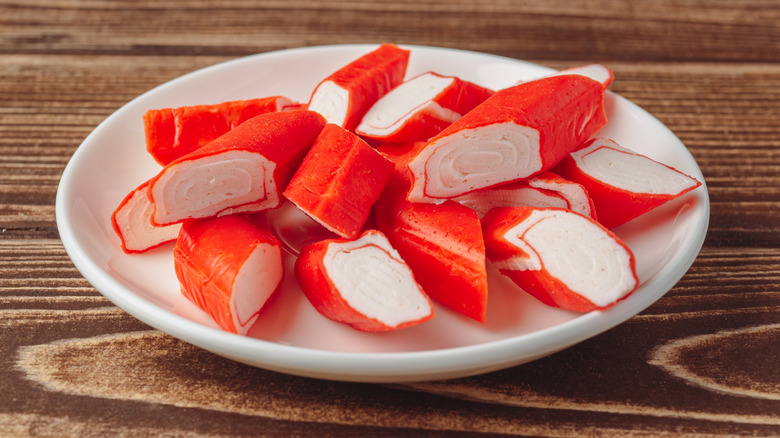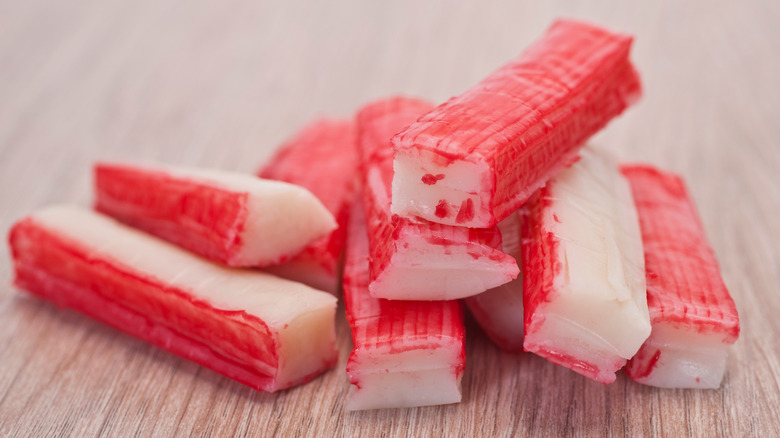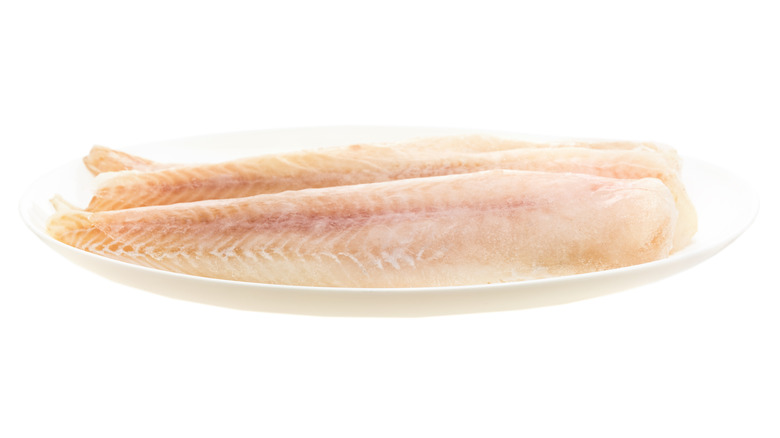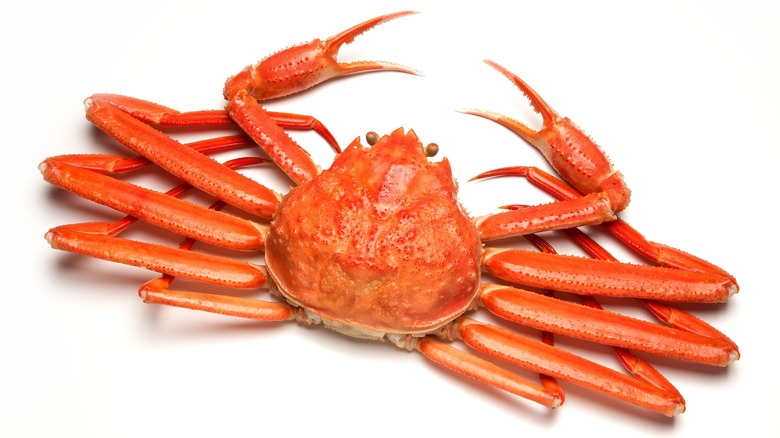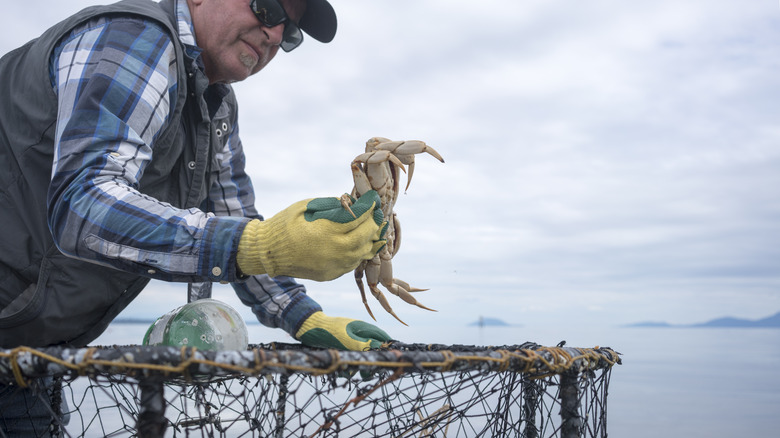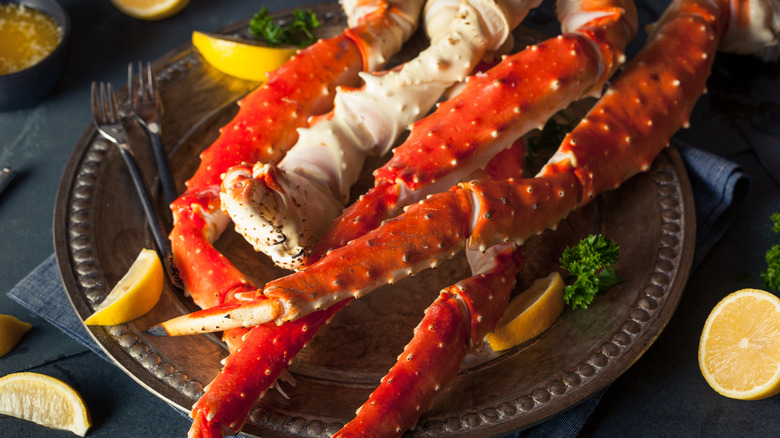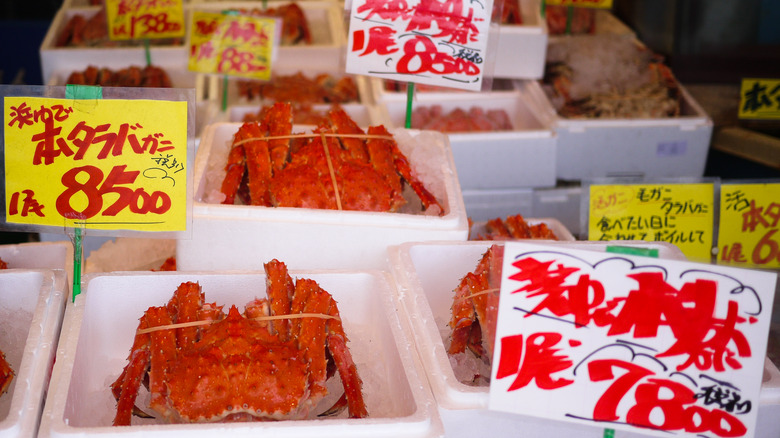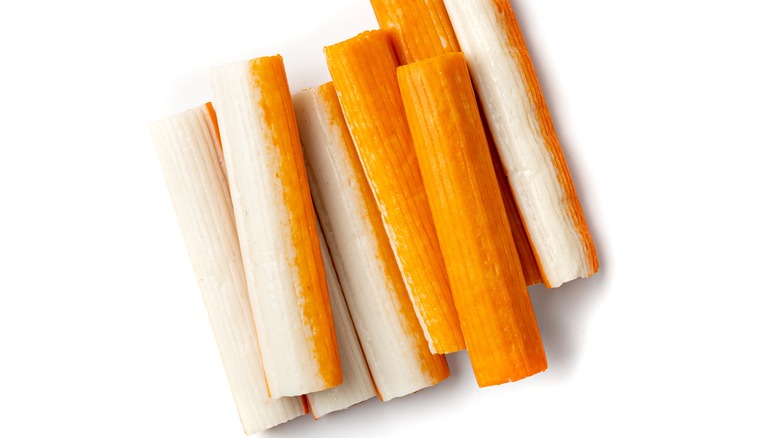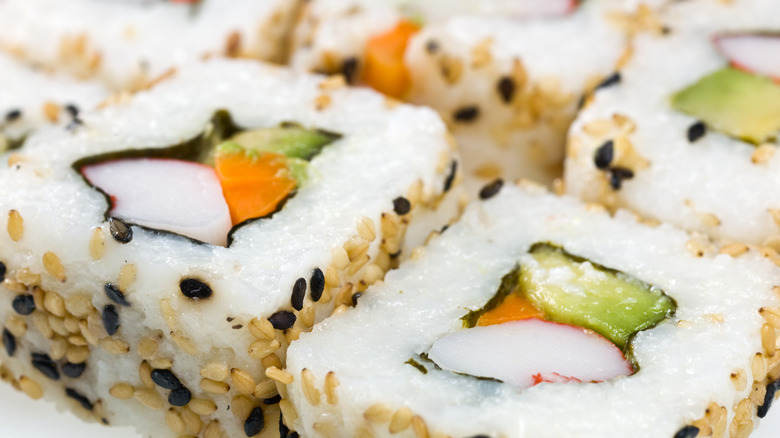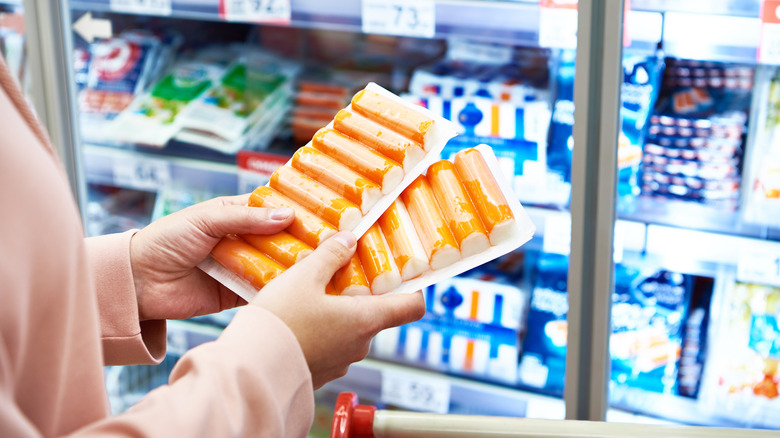Imitation Crab Vs Real Crab: What's The Difference?
If you've ever ordered a California roll at a sushi bar, chances are you've encountered an ingredient that's listed as krab, crab sticks, or imitation crab. But just because it's not made out of real crab doesn't mean this product isn't worth exploring — and potentially even stocking at home.
Imitation crab has long been enjoyed around the world thanks to its slightly sweet flavor and relatively low cost compared to pricey crustacean meat. And while some may balk at the imitation aspect, the reality is that there are quite a few preconceived notions about the product that need some serious debunking. For example, did you know that imitation crab originally hails from Japan and is largely made of actual fish?
So, what's the difference between real crab and the imitation stuff? When do you want to use imitation crab and when is it worthwhile putting money down on the real thing? Here's the low-down on the two distinct but related products to help you make that decision.
What is imitation crab?
Imitation crab is essentially a type of reconstituted fish that may be sold in flake, chunk, or stick form. When it's sold in a stick variety, imitation crab seeks to emulate the shape and texture of meat that's taken from genuine crab legs. But as its name suggests, imitation crab usually doesn't contain any real crab, relying instead on a combination of fish and other ingredients to recreate some of the flavor and texture of crab meat.
While it's tempting to assume that any so-called "fake" food hails from the U.S., this time we've got the Japanese to thank for imitation crab. Invented in 1974 by the Sugiyo company, imitation crab may also be sold as krab in English or kanimam, kamaboko, surimi, or kanikama in Japanese. It's typically used as an ingredient in other dishes and is perhaps best known for its use in California rolls.
In some cultures, meanwhile, imitation crab may be enjoyed all on its own or as the star of a dish. In France, it's often dipped in mayonnaise as a snack, while in Japan it's the main ingredient in kani salad, which unites imitation crab with crunchy cucumber and carrots, sweet corn and mango, and a sriracha-spiced mayonnaise dressing.
Imitation crab is made of white fish and seasonings
The very fact that imitation crab is so often referred to as fake may have you scared of what's actually in this product, but rest assured that there is genuine food here. The main ingredient in imitation crab does indeed hail from the sea — it's just that it's not a crustacean. Imitation crab is typically made of surimi, a processed fish paste that's often made with a mild-tasting white fish such as pollock. Fish stick fans will already be familiar with this flaky fish, a favorite for a wide variety of processed products. A member of the cod family, pollock is popular around the world. It's often served battered and fried in the U.K., smoked in Germany and Denmark, and stewed as part of a rich soup or stock in France.
In addition to surimi, imitation crab typically contains starch of some kind, be it potato, wheat, corn, or tapioca, as well as a protein like egg white or soy. These ingredients give it a firmer texture with more bite and chew. Sugar and sorbitol add sweetness to the mix, which emulates the relatively sweeter flavor of genuine crab. Oil, such as vegetable or fish oil, improves the texture of the meat and the shelf life of the product. Salt and other preservatives also help to boost the flavor and further extend imitation crab's best-by date.
There are many species of real crab
With a mild fishy flavor offset by a touch of sweetness, imitation crab seeks to replicate the taste of real crab ... but which one? Each crab species offers a unique flavor and texture. Blue crabs, for instance, are typically found in the Atlantic (perhaps most notably in the Chesapeake Bay) and the Gulf of Mexico. Beloved for their deep flavor and buttery texture, they are often simply steamed or enjoyed in crab cakes with minimal filler to let the meat shine. The backfin meat of the blue crab is considered the choicest piece, with fans noting it has a texture similar to that of a scallop.
King crabs are known for their massive size, sometimes spanning five feet from leg to leg. King crab boasts a tender texture and an especially rich flavor. Leaner than many other types of crab meat, it's usually served with a big bowl of drawn butter. Dungeness crab is a Pacific treat known for its slightly nutty flavor and tender texture. While there's less meat on each crab than in other species, what is there is highly prized.
Meanwhile, in Florida, stone crab season is time for celebration. Dining on these claws is certainly an experience, as they're usually served with a wooden mallet to crack them open and get at the delicious meat inside. The claws are typically served steamed and then chilled with a side of mustard sauce.
Real crab is seasonal
Real crab stands out from imitation crab in that it's a stalwartly seasonal treat. Blue crabs, for instance, typically spawn around the Carolinas from March to October and will usually be at their largest just after this period. Fishing for crabs after spawning season also helps to combat overfishing, hopefully ensuring that crab populations are not diminished by our taste for the sea's delicious bounty.
In other places, crab season can vary widely depending on which kind of crabs you're looking for and where these crustaceans are coming from. Maryland blue crabs are usually at their best when caught in early fall, while you can only legally harvest Florida's stone crab from October to May. Soft shell crabs, which have a unique texture because they are harvested mid-molt, are more often enjoyed in late spring and summer. By fall, they tend to disappear as the southern waters they frequent grow chilly. Since crab season varies so widely depending on where you live, consulting with a local fishmonger is smart to ensure you're choosing only the best of the local harvest.
Real crab is healthier than imitation crab
Crab boasts many of the same health benefits as other fish and seafood, such as richness in essential nutrients like vitamin B12 and folate, as well as minerals like iron, niacin, selenium, and zinc. Unlike many other popular seafoods, particularly larger fish like tuna and swordfish, crab is far less likely to contain the high levels of mercury that can make overconsumption dangerous or even (in extreme cases) lethal. Crab also typically has plenty of omega-3 fatty acids that can help improve heart and brain health.
While crab itself is relatively healthy, many diners like it best when it's served with drawn butter. While certainly delicious, butter makes this delicacy quite a bit richer and heavier. While the days of demonizing all fats are over, butter should still be consumed in moderation given its high saturated fat content. Pairing crab with a source lower in saturated fat, such as the avocado beloved in crab recipes like crab-stuffed avocado halves, is for most people a more heart-healthy choice.
The health benefits of crab are not necessarily shared by imitation crab, which is generally poorer in essential nutrients, with significantly less protein, vitamins, and minerals than the real thing. Many varieties of imitation crab also contain artificial ingredients like food coloring as well as added sugar. While imitation crab isn't necessarily bad for you, it's rarely as nutritious as crab itself.
Real crab is keto-friendly
The keto diet has become popular of late, thanks to the ever-growing body of research touting the health benefits of this low-carb, high-fat diet. One 2014 study in the International Journal of Environmental Research and Public Health indicates that a physician-approved keto diet could promote weight loss, while a 2018 review in the Expert Review of Endocrinology & Metabolism indicates that keto may help manage the symptoms of type 2 diabetes. A 2019 study in Nutrients suggests that a keto diet may help manage symptoms of drug-resistant epilepsy, while another 2019 paper published in the International Journal of Molecular Sciences shows promise that a keto diet could help mitigate symptoms of Alzheimer's disease. Furthermore, a 2018 study in Aging explored how a keto diet could be used to support cancer treatments.
While crab is relatively low in fat, with just 1.3 grams per three-ounce serving, it's still keto-friendly thanks to its mere 0.95 grams of net carbs. Imitation crab, however, is not a great choice for a keto diet, largely because of the added starches and sugars found in many brands, which contribute to the estimated 12.8 grams of carbs per three-ounce serving — about the same amount as in three ounces of apples. Since apples are a higher-sugar fruit, they're not the best choice for keto-minded eaters, either — and imitation crab, devoid of the fiber that helps the sugars in apples release more slowly into your bloodstream, is potentially even worse.
Imitation crab is cheaper than real crab
Take a look at your local seafood counter, and you'll see that crab is not the cheapest of seafood choices, fetching as much as $60 per pound for beloved king crab in some markets. Even canned lump crabmeat costs about $5.50 per six-ounce can, or about $14 per pound, which puts the crustacean on par with ribeye steak.
That's just the beginning. On some occasions, rare giant spider crabs or snow crabs have fetched prices as high as $12,000 for the former or a whopping $46,000 for the latter. Crab's expensive nature is linked to several factors including population crashes connected to climate change and warming ocean waters, as well as the time-consuming nature of catching and shipping this bounty.
Imitation crab, meanwhile, is far more reasonably priced. Indeed, this is a large part of its draw. Imitation crab was originally invented in the 1970s as a cheaper alternative to the real thing, after all. These days, you'll likely pay somewhere from $3 to $10 for an eight-ounce bag of imitation crab. More expensive brands, especially those from Japan, typically contain at least some real crab meat. Meanwhile, less expensive iterations rely entirely on cheaper fish-based surimi to get that seafood flavor and flair without the cost.
Imitation crab's texture is more rubbery than the real thing
Many versions of imitation crab include loads of additives that attempt to give it a similar texture to the real thing, but let's be honest here — there's no comparison. Depending on the variety of crab you choose, you're likely to encounter a unique texture that ranges from flaky to meaty. Once cooked, crab also tends to be easy to flake or shred with a fork. Imitation crab, meanwhile, may be rubbery or chewy, with a flake style that has a texture more similar to a pencil eraser. Imitation crab sticks, which emulate the shape of legs, tend to be more stringy and easier to shred, making them more enjoyable because their toughness is significantly diminished once shredded.
Combining imitation crab with more textured ingredients, like crunchy scallions or creamy mayonnaise, can improve the eating experience significantly. Sautéeing or even baking imitation crab can also boost the texture, especially if you add a crispy breadcrumb coating for a bit of crunch. But be forewarned: Since imitation crab is sold already cooked and ready to eat, it's easy to overcook, which will only serve to highlight its rubbery texture. If you find the texture of imitation crab tough to swallow, opt for a cold preparation like a crab salad or sushi roll, to keep its texture from growing even tougher.
Imitation crab is more user-friendly and great for cooking
Aside from the occasionally astronomical pricing, one major barrier to entry for many diners when it comes to enjoying crab is the work required to prepare and eat it. While some crab is sold cooked and only need to be shelled before it's ready to eat, much of the time, crabs are sold live. This means that the crustaceans have to be killed and cooked before being shelled. However you get there, this process can be difficult or even dangerous when it calls for sharp-edged tools. This leads more cautious cooks to opt for canned crab or imitation crab.
While there's no contest in terms of flavor and texture, imitation crab is way easier to use than the real stuff. Most sushi bars use imitation crab in California rolls, where its lower price point makes it a no-brainer. These and other imitation crab recipes typically pair the protein with other flavorful ingredients like cream, cheese, or spicy jalapeño as in crab rangoon or hot crab dip.
Some recipe testers even find that they prefer the less assertive flavor of imitation crab in dishes like these. A similar argument might be used in favor of imitation crab in spiced Louisiana-style crab cakes. Imitation crab also works well in cold dishes like pasta salad, where it can be combined with other ingredients without either overpowering them or getting lost behind more assertive flavors.
Not all brands of imitation crab are created equal
Within the greater category of imitation crab, there's loads of variety in terms of flavor, texture, form, and quality. Depending on how much you're willing to invest in the product, you may come away with something that's fairly tasty and pleasant to eat or something with a too-sweet, too-processed flavor and overly firm texture.
Low-grade imitation crab brands often use surimi that's been compressed into flakes or chunks. This form of imitation crab is usually the least sought-after, given that the texture may be gummy, chewy, or rubbery. The flavor of these products will typically offer the biggest departure from real crab, too, offering only the most vague of seafood-like aromas that are easily overpowered by pronounced sweetness. A better option is crab sticks, which are essentially logs of easily shredded imitation crab. Their more fibrous nature better emulates the texture of real crab, plus it makes them easier to disassemble, which can improve your eating experience significantly.
In Japan, you can even get your hands on high-end imitation crab, which has gone so far as to emulate not just the flavor but the smell of real crab. It may even be sold in the fish section rather than with the other fish cakes and pastes, signaling its high-end appeal.
Imitation crab may contribute to overfishing
While it may seem counterintuitive, imitation crab could be more of a threat to the health of our oceans, given its connection to overfishing. Crab stocks around the world tend to be fairly strictly monitored, and many regions with sought-after crab species, like Florida's stone crabs, usually impose strict seasons and quotas for harvesting. Yet the main ingredient in imitation crab does not always enjoy the same protection.
Pollock has historically been significantly overfished, with a whopping 50% decline recorded back in 2010. These plummeting pollock numbers could have jeopardized the entire food chain, especially endangered species that relied on it as a staple food, like sea lions. Thankfully, in the past decade or so, major strides have been taken to improve the management of pollock fisheries, like reducing overfishing. Other measures have worked to reduce bycatch, specifically that of Chinook salmon, by carefully monitoring the contents of trawler nets and testing a new salmon excluder device so that fewer non-pollock fish get caught. That said, some pollock fisheries, including those targeting Walleye or Pacific pollock trawled in the Bering Sea, remain mismanaged and are still poor choices from an eco-conscious standpoint. If your crab stick brand of choice isn't transparent about its origins, consider swapping it for a brand that can guarantee the sustainability of its most important ingredient.
